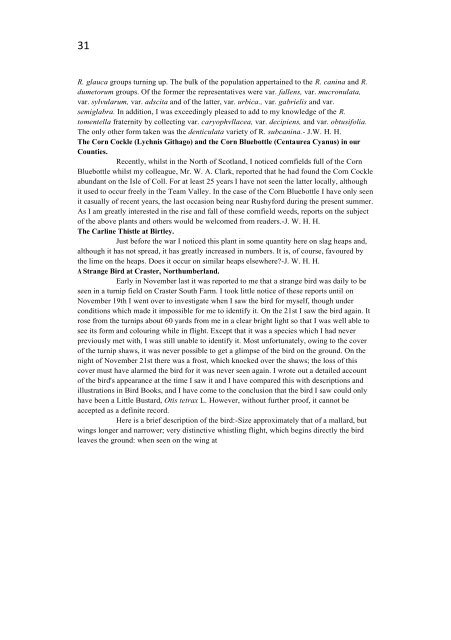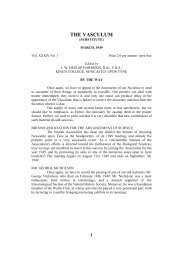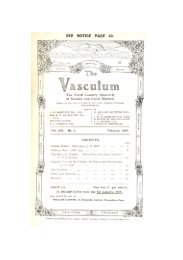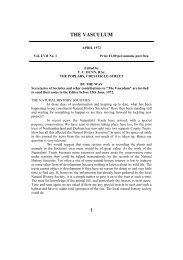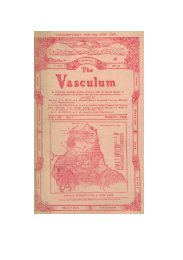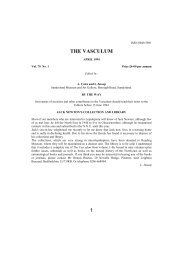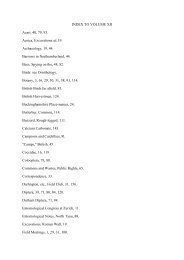1938 - The Vasculum
1938 - The Vasculum
1938 - The Vasculum
Create successful ePaper yourself
Turn your PDF publications into a flip-book with our unique Google optimized e-Paper software.
31<br />
R. glauca groups turning up. <strong>The</strong> bulk of the population appertained to the R. canina and R.<br />
dumetorum groups. Of the former the representatives were var. fallens, var. mucronulata,<br />
var. sylvularum, var. adscita and of the latter, var. urbica., var. gabrielis and var.<br />
semiglabra. In addition, I was exceedingly pleased to add to my knowledge of the R.<br />
tomentella fraternity by collecting var. caryophvllacea, var. decipiens, and var. obtusifolia.<br />
<strong>The</strong> only other form taken was the denticulata variety of R. subcanina.- J.W. H. H.<br />
<strong>The</strong> Corn Cockle (Lychnis Githago) and the Corn Bluebottle (Centaurea Cyanus) in our<br />
Counties.<br />
Recently, whilst in the North of Scotland, I noticed cornfields full of the Corn<br />
Bluebottle whilst my colleague, Mr. W. A. Clark, reported that he had found the Corn Cockle<br />
abundant on the Isle of Coll. For at least 25 years I have not seen the latter locally, although<br />
it used to occur freely in the Team Valley. In the case of the Corn Bluebottle I have only seen<br />
it casually of recent years, the last occasion being near Rushyford during the present summer.<br />
As I am greatly interested in the rise and fall of these cornfield weeds, reports on the subject<br />
of the above plants and others would be welcomed from readers.-J. W. H. H.<br />
<strong>The</strong> Carline Thistle at Birtley.<br />
Just before the war I noticed this plant in some quantity here on slag heaps and,<br />
although it has not spread, it has greatly increased in numbers. It is, of course, favoured by<br />
the lime on the heaps. Does it occur on similar heaps elsewhere?-J. W. H. H.<br />
A Strange Bird at Craster, Northumberland.<br />
Early in November last it was reported to me that a strange bird was daily to be<br />
seen in a turnip field on Craster South Farm. I took little notice of these reports until on<br />
November 19th I went over to investigate when I saw the bird for myself, though under<br />
conditions which made it impossible for me to identify it. On the 21st I saw the bird again. It<br />
rose from the turnips about 60 yards from me in a clear bright light so that I was well able to<br />
see its form and colouring while in flight. Except that it was a species which I had never<br />
previously met with, I was still unable to identify it. Most unfortunately, owing to the cover<br />
of the turnip shaws, it was never possible to get a glimpse of the bird on the ground. On the<br />
night of November 21st there was a frost, which knocked over the shaws; the loss of this<br />
cover must have alarmed the bird for it was never seen again. I wrote out a detailed account<br />
of the bird's appearance at the time I saw it and I have compared this with descriptions and<br />
illustrations in Bird Books, and I have come to the conclusion that the bird I saw could only<br />
have been a Little Bustard, Otis tetrax L. However, without further proof, it cannot be<br />
accepted as a definite record.<br />
Here is a brief description of the bird:-Size approximately that of a mallard, but<br />
wings longer and narrower; very distinctive whistling flight, which begins directly the bird<br />
leaves the ground: when seen on the wing at


